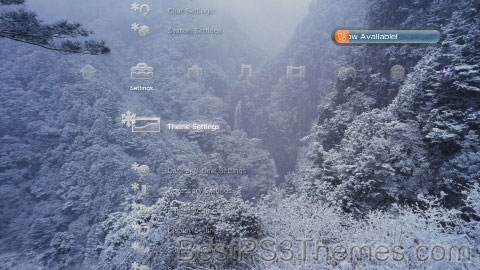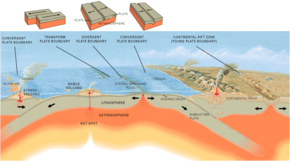Uncharted theme by Sony
Download: Uncharted.p3t

(1 background)
| Uncharted | |
|---|---|
| Genre(s) | Action-adventure, third-person shooter |
| Developer(s) |
|
| Publisher(s) | Sony Interactive Entertainment |
| Creator(s) | Amy Hennig |
| Platform(s) | |
| First release | Uncharted: Drake's Fortune November 19, 2007 |
| Latest release | Uncharted: Legacy of Thieves Collection January 28, 2022 |
Uncharted is an action-adventure video game series and media franchise published by Sony Interactive Entertainment and developed by Naughty Dog. Created by Amy Hennig, the Uncharted franchise follows a group of treasure hunters who travel across the world to uncover various historical mysteries. The series features historical fiction, elements of fantasy and folklore, and fictional characters alongside real-world historical figures and events. In the main series, players control Nathan Drake; in the expansion, players control Chloe Frazer.
The franchise's first game, Uncharted: Drake's Fortune, was released in 2007, and followed by the sequels Uncharted 2: Among Thieves (2009), Uncharted 3: Drake's Deception (2011), and Uncharted 4: A Thief's End (2016). Spin-offs Uncharted: Golden Abyss (2011), Uncharted: Fight for Fortune (2012), and the standalone expansion Uncharted: The Lost Legacy (2017) also support the main series. Originally published exclusively for PlayStation consoles, the franchise later released games for other platforms, with the mobile spin-off Uncharted: Fortune Hunter (2016) and remasters of A Thief's End and The Lost Legacy for Windows in 2022.
The main games are played from a third-person perspective, with gameplay mostly revolving around combat, shooting, exploration, and puzzles, while platforming is used to navigate the environment. Later titles began including competitive and co-operative multiplayer game modes, stealth, and driving gameplay. Uncharted drew inspiration from other games,[1] film, and additional media, and is known for featuring exotic locations. Several adaptations of the series have also been released, including a live-action film, board games, comics, and a novel.
The main series received critical acclaim, with praise for the stories, characters, voice acting, gameplay, graphics, and replayability, with its high production value being frequently compared to Hollywood-produced action-adventure films. It has also been credited by critics and publications for raising standards for single-player games, and its second and fourth numbered installments are consistently ranked among the greatest video games. Uncharted has shipped over 41 million units, making it one of the best-selling video game franchises, helping the success of PlayStation during the seventh and eighth generation and elevating Naughty Dog's reputation as a developer.
Titles[edit]
Main series[edit]
| 2007 | Drake's Fortune |
|---|---|
| 2008 | |
| 2009 | Among Thieves |
| 2010 | |
| 2011 | Drake's Deception |
| Golden Abyss | |
| 2012 | Fight for Fortune |
| 2013–2014 | |
| 2015 | The Nathan Drake Collection |
| 2016 | A Thief's End |
| Uncharted: Fortune Hunter | |
| 2017 | The Lost Legacy |
| 2018–2021 | |
| 2022 | Uncharted: Legacy of Thieves Collection |
| Year | Title | Developer | Platforms |
|---|---|---|---|
| 2007 | Uncharted: Drake's Fortune | Naughty Dog | PlayStation 3 |
| 2009 | Uncharted 2: Among Thieves | ||
| 2011 | Uncharted 3: Drake's Deception | ||
| Uncharted: Golden Abyss | Bend Studio | PlayStation Vita | |
| 2012 | Uncharted: Fight for Fortune | ||
| 2015 | Uncharted: The Nathan Drake Collection[a] | Bluepoint Games | PlayStation 4 |
| 2016 | Uncharted 4: A Thief's End | Naughty Dog | |
| Uncharted: Fortune Hunter | Playspree | Android, iOS | |
| 2017 | Uncharted: The Lost Legacy[b] | Naughty Dog | PlayStation 4 |
| 2022 | Uncharted: Legacy of Thieves Collection[c] | PlayStation 5 | |
| Iron Galaxy | Windows |
Notes:
Drake's Fortune, the first game in the series, was released for PlayStation 3 in November 2007.[2] The system carried the following two installments of the main series, after Naughty Dog agreed to exclusively release the games on Sony systems. Among Thieves was published in 2009, and the creative team were afforded a greater license to utilize a larger amount of the system's random-access memory (RAM), due to an improved proprietary engine. It subsequently introduced more locales, higher free roam and combat abilities, and a larger map. Drake's Deception, released in 2011, built upon this aspect, while it also added an improved online multiplayer mode.
The following main installment, A Thief's End, was published on PlayStation 4, and focused on realism and detail. The last in the series to feature the main protagonist, it added driving elements and improved other gameplay aspects, like stealth and role-playing, and comprehensive upgrades to multiplayer. It was released to massive financial success, breaking multiple records.[3] A free-to-play game for iOS and Android, Fortune Hunter, was released to tie in with A Thief's End.[4][5]
Other games and compilations[edit]
Golden Abyss was published in 2011, and is the first in the series to be released on PlayStation Vita, marking the series' first on a handheld console. It is considered a prequel to the main series, although, some developers have stated that it acts as a separate, original story.[6] In 2012, a turn-based card game titled Fight for Fortune was released. It was developed by One Loop Games,[7][8] and contained interactive elements suitable for the Vita.[9]
Drake's Trail is a now-defunct 2007 online game. The game was a browser-based game[10] with alternative reality elements. Consisting of ten chapters, the story, serving as a prequel to Drake's Fortune, recounts journalist Elena Fisher hiring a private detective to track down famous treasure hunter Nathan Drake believing he is onto something big. The game was played using a Google Maps plugin to locate game areas within the real world, in conjunction with a Flash Player to explore those fictional locations (such as Drake's apartment) for clues to the next location.
The Nathan Drake Collection is a remastered collection of the series' first three installments, and was ported to PlayStation 4 by Bluepoint Games in October 2015. It was released to compensate for the delay in production for A Thief's End, which was originally slated for release in summer 2015. The game also included a voucher for the beta for the multiplayer for A Thief's End.[11] The games feature enhancements such as new trophies, an in-game Photo Mode, and improved textures and gameplay. The multiplayer modes from Uncharted 2 and Uncharted 3 are excluded.[12] It received positive reviews, with most praising the technical improvements and visual enhancements.[13] The game was offered for free as part of Sony's Play at Home initiative during the COVID-19 pandemic in April–May 2020.[14][15]
The Lost Legacy was released as a standalone expansion to A Thief's End, and marks the first entry in the series not to feature Drake. It features the characters Chloe Frazer and Nadine Ross, who previously appeared in Among Thieves and Drake's Deception, and A Thief's End, respectively.[16] It was released on PlayStation 4 in 2017.[17] Uncharted: Legacy of Thieves Collection, a remastered version of A Thief's End and The Lost Legacy, was released on January 28, 2022, for PlayStation 5;[18] a Windows version, developed in collaboration with Iron Galaxy, was released on October 19, 2022.[19]
Common elements[edit]
Gameplay[edit]
Gameplay in the Uncharted series is a combination of action-adventure elements and 3D platforming with a third-person perspective. The player is given various physical tasks which must be completed to progress through the storyline, such as jumping, swimming, grabbing and moving along ledges, and climbing and swinging from ropes.[20] Other aspects, including shooting, combat, and puzzle solving, also regularly feature. In later titles, driving, boat riding, and other acrobatic actions were added or developed.
The Uncharted games grant a reasonable amount of freedom through the design of the maps. Later games contain elements of open world design, in order to encourage free-roaming to secure collectibles or stealth to avoid enemies.[20] In A Thief's End, role-playing was expanded to include side discussions with other characters. The Uncharted series follows the structure of traditional action games, where players complete a single track series of levels with linear gameplay, and is navigated through a third-person perspective.
Shooting is central to the game's function, as players are also required to bypass a string of foes. Although a wide variety of weapons are present in the game, the player can only carry a sidearm such as pistol, a primary weapon such as a rifle or shotgun, and a handful of grenades. These weapons are obtained by picking up weapons dropped by a downed foe, or from those scattered around the various maps. If the player dies, they will respawn at a specific level checkpoint.[21]
In A Thief's End, the use of vehicles in an explorable environment was developed. It provides the player with freedom to take vehicles wherever they please, albeit, must be driven to a certain location to progress the story.[22]
In Among Thieves, multiplayer was introduced. It features both competitive and co-operative gameplay. The co-op multiplayer mode allows up to three players to take the roles of Drake and two other "hero" companions and features missions involving gunfights, platforming, and teamwork-based objectives.[23] Players can also assist their comrades if they become critically injured or if they are grabbed by an enemy.[23] The competitive multiplayer allows a maximum of ten players to play against each other in two teams of five. Six competitive modes are featured, including single or team-based deathmatches, and team-based objectives.[24] In A Thief's End, survival mode was introduced, which features wave-based progression on swarms of increasingly powerful enemies, as well as completing other objectives. Furthermore, multiplayer allows players to accrue points and rank up, which can be used to purchase more skins for both heroes and villains.[24]
Setting[edit]
In Uncharted: Drake's Fortune, the game is set off the coast of Panama, in the Amazon rainforest, and an uncharted island off the coast of South America. The second entry in the franchise, Uncharted 2: Among Thieves, was the first in the series to experiment with several locales. The game is set in the snow-capped mountain landscapes of the Tibetan Plateau in southernmost China, a museum in Istanbul, the jungles of Borneo, and the urban landscapes of Nepal. Subsequent games followed this concept, with Uncharted 3: Drake's Deception featuring the streets of London and Colombia, as well as a château in France, a castle in Syria, a city in Yemen, and the sprawling deserts of the Rub' al Khali.
Uncharted 4: A Thief's End features a Panamanian jail, an estate in Italy, a cathedral in Scotland, several locations in Madagascar, and many uncharted islands in the Indian Ocean not far from Africa, to reflect Libertalia. Boston and New Orleans are also included, in both the past and present respectively, where the titular character resides.
The prequel game Uncharted: Golden Abyss features a dig site and several other locales set in the forests of Panama while the standalone expansion Uncharted: The Lost Legacy features the locales set in and around the mountain ranges of Western Ghats in India as well as a small bazaar and a city in Tamil Nadu.
Many of the locations represented were extensively researched for the series. The development team organized field research trips with tour guides and architectural historians and captured many photos and hours of video footage to properly reflect the settings.
Characters[edit]
The series has included a wide variety of voice actors, with the development team settling on the decision that prominent characters would be voiced by lower profile actors. Only three characters have featured in every main installment, while Chloe is the only other single-player playable character:
- Nathan is portrayed as a professional treasure hunter with a shady background. He is physically fit, highly intelligent, self-educated in history and various languages, and a supposed descendant of Sir Francis Drake. Naughty Dog gave Drake a very strong personality, as they did not want him to act blandly, thus he often thinks out loud and comments on and complains about the absurdity of his situations.[25] Although naturally handsome, Drake's appearance is generic and not excessively muscular, usually appearing in a plain shirt and jeans to portray the everyman persona. North also strongly mixed in his own personality with Drake's, ad-libbing portions of the character's dialogue and improvising numerous scenes.[26]
- Elena is an investigative journalist, who often finds herself on the same excursions as Drake. They begin a relationship, and eventually marry and have a child. Naughty Dog initially designed Elena solely as a sidekick and a romantic interest to Drake, and her personality to complement his. However, she grows to be as capable as Drake at gun battles and resourcefulness.[27] Rose commented that "in the first game, she's a lot younger, she's a lot more naive, and she looks at things as being very possible, and in the second [game], has seen murders and adventure... the way that any person grows, you see that in her. She's a little bit more hesitant, a little more cynical".[28] The games tell the story of her romantic relationship with Drake.[29][30][31]
- A former U.S. Navy officer, Sullivan is a skilled traveler, able to navigate planes and submarines. He is also able to engage in similar gun battles as Drake, and is adept at star-based navigation. Sullivan is Drake's mentor and father figure, having picked him up as a wandering orphan in Colombia. Naughty Dog also designed him to fit the everyman persona, as he clads himself in odd guayabera-style shirts, khaki pants, and smokes cigars. He is also constantly in debt, and often relies on other people to fund the pair's adventures.[32]
- The only other single-player playable character, Chloe was designed to be a darker version of the main character, and a stark contrast to Elena. She is an impulsive and reckless adventurer, and is witty, devious, and fun-seeking.[33] Chloe is also a very sexually forward character, using it to help further her interests. At first, she appears selfish, caring little for anything but her goal, but is later seen as a very loyal and determined character. She is as skilled as Drake and Sullivan in gun battles and fights, while Black also ad-libbed segments of dialog to influence Chloe's personality.[34][35]
Other media[edit]
Games[edit]
Uncharted: The Board Game[edit]
Uncharted: The Board Game is a board game published by Bandai in 2012. It was designed by Hayato Kisaragi and allows between two and four players to compete for treasure and fight enemies.[36]
Comics[edit]
Uncharted: Eye of Indra[edit]
Sony Computer Entertainment America released the first of a four-part motion comic series adventure called Uncharted: Eye of Indra on October 23, 2009.[37] It is a prequel to Uncharted: Drake's Fortune. The second part was released on November 25, while the third and fourth parts released simultaneously on December 7.[38]
Uncharted: Drake's Fortune[edit]
A motion comic adaptation of the prologue of Uncharted: Drake's Fortune, starting with the discovery of Francis Drake's coffin and up to the first encounter with Gabriel Roman. Uses the same voice clips from the video game.
Uncharted[edit]
An Uncharted comic book was released by DC Comics around the time Uncharted 3 came out. Written by Joshua Williamson, with art by Sergio Sandoval and covers by Adam Hughes, it was released on November 30, 2011, as part of a 6-issue mini series.[39][40] In the story, a quest for the legendary "Amber Room" launches Nathan Drake on a journey to the Hollow Earth.[41]
Novel[edit]
A novel titled Uncharted: The Fourth Labyrinth was published in October 2011. The novel is written by Christopher Golden and published by Del Rey Books, and follows the search for Daedalus's Labyrinth, a maze used to hold the Minotaur, a monster from Greek mythology.[42]
Film adaptation[edit]
Ruben Fleischer directed a film adaptation of the games, from a script by Art Marcum and Matt Holloway. The film starred Tom Holland (who also serves as an executive producer) as Nathan Drake and Mark Wahlberg as Victor Sullivan. Antonio Banderas, Sophia Taylor Ali, and Tati Gabrielle were cast in supporting roles.[43] It was theatrically released in the United States on February 18, 2022, produced by Columbia Pictures, Atlas Entertainment, and Arad Productions.[44] PlayStation Productions executive produced, while Sony Pictures Releasing distributed.[45] In August 2023, producer Charles Roven said the studio was "definitely looking to make" a sequel.[46] Sony confirmed a sequel was in development by June 2024.[47]
Fan film[edit]
In July 2018, director Allan Ungar posted a fan-made 15-minute short film, starring Nathan Fillion as Nathan Drake, who for years had been campaigning for the role. It was very well received, with particular praise given to Fillion's performance as Drake, and to an action sequence shot from an over-the-shoulder angle, similar to the shooting sequences in the video games. The short also features Stephen Lang as Victor Sullivan and Mircea Monroe as Elena Fisher, with appearances from Ernie Reyes Jr. and Geno Segers.[48][49] The reception towards the fan film resulted in some speculation as to whether it would influence and alter the plans of the official film. Druckmann, vice-president of Naughty Dog, tweeted a heart emoji towards the fan film, with film director Shawn Levy also praising it,[50] while Ungar expressed his support towards the official film.[51]
Th
Classy Pink
Classy Pink theme by Sony
Download: ClassyPink.p3t

(1 background)
P3T Unpacker v0.12
Copyright (c) 2007. Anoop Menon
This program unpacks Playstation 3 Theme files (.p3t) so that you can touch-up an existing theme to your likings or use a certain wallpaper from it (as many themes have multiple). But remember, if you use content from another theme and release it, be sure to give credit!
Download for Windows: p3textractor.zip
Instructions:
Download p3textractor.zip from above. Extract the files to a folder with a program such as WinZip or WinRAR. Now there are multiple ways to extract the theme.
The first way is to simply open the p3t file with p3textractor.exe. If you don’t know how to do this, right click the p3t file and select Open With. Alternatively, open the p3t file and it will ask you to select a program to open with. Click Browse and find p3textractor.exe from where you previously extracted it to. It will open CMD and extract the theme to extracted.[filename]. After that, all you need to do for any future p3t files is open them and it will extract.
The second way is very simple. Just drag the p3t file to p3textractor.exe. It will open CMD and extract the theme to extracted.[filename].
For the third way, first put the p3t file you want to extract into the same folder as p3textractor.exe. Open CMD and browse to the folder with p3extractor.exe. Enter the following:
p3textractor filename.p3t [destination path]Replace filename with the name of the p3t file, and replace [destination path] with the name of the folder you want the files to be extracted to. A destination path is not required. By default it will extract to extracted.filename.
Nature
Nature theme by Sony
Download: Nature.p3t

(1 background)

Nature is an inherent character or constitution,[1] particularly of the ecosphere or the universe as a whole. In this general sense nature refers to the laws, elements and phenomena of the physical world, including life. Although humans are part of nature, human activity or humans as a whole are often described as at times at odds, or outright separate and even superior to nature.[2]
During the advent of modern scientific method in the last several centuries, nature became the passive reality, organized and moved by divine laws.[3][4] With the Industrial revolution, nature increasingly became seen as the part of reality deprived from intentional intervention: it was hence considered as sacred by some traditions (Rousseau, American transcendentalism) or a mere decorum for divine providence or human history (Hegel, Marx). However, a vitalist vision of nature, closer to the pre-Socratic one, got reborn at the same time, especially after Charles Darwin.[2]
Within the various uses of the word today, "nature" often refers to geology and wildlife. Nature can refer to the general realm of living plants and animals, and in some cases to the processes associated with inanimate objects—the way that particular types of things exist and change of their own accord, such as the weather and geology of the Earth. It is often taken to mean the "natural environment" or wilderness—wild animals, rocks, forest, and in general those things that have not been substantially altered by human intervention, or which persist despite human intervention. For example, manufactured objects and human interaction generally are not considered part of nature, unless qualified as, for example, "human nature" or "the whole of nature". This more traditional concept of natural things that can still be found today implies a distinction between the natural and the artificial, with the artificial being understood as that which has been brought into being by a human consciousness or a human mind. Depending on the particular context, the term "natural" might also be distinguished from the unnatural or the supernatural.[2]
Etymology[edit]
The word nature is borrowed from the Old French nature and is derived from the Latin word natura, or "essential qualities, innate disposition", and in ancient times, literally meant "birth".[5] In ancient philosophy, natura is mostly used as the Latin translation of the Greek word physis (φύσις), which originally related to the intrinsic characteristics of plants, animals, and other features of the world to develop of their own accord.[6][7] The concept of nature as a whole, the physical universe, is one of several expansions of the original notion;[2] it began with certain core applications of the word φύσις by pre-Socratic philosophers (though this word had a dynamic dimension then, especially for Heraclitus), and has steadily gained currency ever since.
Earth[edit]
−13 — – −12 — – −11 — – −10 — – −9 — – −8 — – −7 — – −6 — – −5 — – −4 — – −3 — – −2 — – −1 — – 0 — |
| |||||||||||||||||||||||||||||||||||||||

Earth is the only planet known to support life, and its natural features are the subject of many fields of scientific research. Within the Solar System, it is third closest to the Sun; it is the largest terrestrial planet and the fifth largest overall. Its most prominent climatic features are its two large polar regions, two relatively narrow temperate zones, and a wide equatorial tropical to subtropical region.[8] Precipitation varies widely with location, from several metres of water per year to less than a millimetre. 71 percent of the Earth's surface is covered by salt-water oceans. The remainder consists of continents and islands, with most of the inhabited land in the Northern Hemisphere.
Earth has evolved through geological and biological processes that have left traces of the original conditions. The outer surface is divided into several gradually migrating tectonic plates. The interior remains active, with a thick layer of plastic mantle and an iron-filled core that generates a magnetic field. This iron core is composed of a solid inner phase, and a fluid outer phase. Convective motion in the core generates electric currents through dynamo action, and these, in turn, generate the geomagnetic field.
The atmospheric conditions have been significantly altered from the original conditions by the presence of life-forms,[9] which create an ecological balance that stabilizes the surface conditions. Despite the wide regional variations in climate by latitude and other geographic factors, the long-term average global climate is quite stable during interglacial periods,[10] and variations of a degree or two of average global temperature have historically had major effects on the ecological balance, and on the actual geography of the Earth.[11][12]
Geology[edit]
Geology is the science and study of the solid and liquid matter that constitutes the Earth. The field of geology encompasses the study of the composition, structure, physical properties, dynamics, and history of Earth materials, and the processes by which they are formed, moved, and changed. The field is a major academic discipline, and is also important for mineral and hydrocarbon extraction, knowledge about and mitigation of natural hazards, some Geotechnical engineering fields, and understanding past climates and environments.
Geological evolution[edit]

The geology of an area evolves through time as rock units are deposited and inserted and deformational processes change their shapes and locations.
Rock units are first emplaced either by deposition onto the surface or intrude into the overlying rock. Deposition can occur when sediments settle onto the surface of the Earth and later lithify into sedimentary rock, or when as volcanic material such as volcanic ash or lava flows, blanket the surface. Igneous intrusions such as batholiths, laccoliths, dikes, and sills, push upwards into the overlying rock, and crystallize as they intrude.
After the initial sequence of rocks has been deposited, the rock units can be deformed and/or metamorphosed. Deformation typically occurs as a result of horizontal shortening, horizontal extension, or side-to-side (strike-slip) motion. These structural regimes broadly relate to convergent boundaries, divergent boundaries, and transform boundaries, respectively, between tectonic plates.
Historical perspective[edit]

Earth is estimated to have formed 4.54 billion years ago from the solar nebula, along with the Sun and other planets.[13] The Moon formed roughly 20 million years later. Initially molten, the outer layer of the Earth cooled, resulting in the solid crust. Outgassing and volcanic activity produced the primordial atmosphere. Condensing water vapor, most or all of which came from ice delivered by comets, produced the oceans and other water sources.[14] The highly energetic chemistry is believed to have produced a self-replicating molecule around 4 billion years ago.[15]

Continents formed, then broke up and reformed as the surface of Earth reshaped over hundreds of millions of years, occasionally combining to make a supercontinent. Roughly 750 million years ago, the earliest known supercontinent Rodinia, began to break apart. The continents later recombined to form Pannotia which broke apart about 540 million years ago, then finally Pangaea, which broke apart about 180 million years ago.[17]
During the Neoproterozoic era, freezing temperatures covered much of the Earth in glaciers and ice sheets. This hypothesis has been termed the "Snowball Earth", and it is of particular interest as it precedes the Cambrian explosion in which multicellular life forms began to proliferate about 530–540 million years ago.[18]
Since the Cambrian explosion there have been five distinctly identifiable mass extinctions.[19] The last mass extinction occurred some 66 million years ago, when a meteorite collision probably triggered the extinction of the non-avian dinosaurs and other large reptiles, but spared small animals such as mammals. Over the past 66 million years, mammalian life diversified.[20]
Several million years ago, a species of small African ape gained the ability to stand upright.[16] The subsequent advent of human life, and the development of agriculture and further civilization allowed humans to affect the Earth more rapidly than any previous life form, affecting both the nature and quantity of other organisms as well as global climate. By comparison, the Great Oxygenation Event, produced by the proliferation of algae during the Siderian period, required about 300 million years to culminate.
The present era is classified as part of a mass extinction event, the Holocene extinction event, the fastest ever to have occurred.[21][22] Some, such as E. O. Wilson of Harvard University, predict that human destruction of the biosphere could cause the extinction of one-half of all species in the next 100 years.[23] The extent of the current extinction event is still being researched, debated and calculated by biologists.[24][25][26]
Atmosphere, climate, and weather[edit]

The Earth's atmosphere is a key factor in sustaining the ecosystem. The thin layer of gases that envelops the Earth is held in place by gravity. Air is mostly nitrogen, oxygen, water vapor, with much smaller amounts of carbon dioxide, argon, etc. The atmospheric pressure declines steadily with altitude. The ozone layer plays an important role in depleting the amount of ultraviolet (UV) radiation that reaches the surface. As DNA is readily damaged by UV light, this serves to protect life at the surface. The atmosphere also retains heat during the night, thereby reducing the daily temperature extremes.
Terrestrial weather occurs almost exclusively in the lower part of the atmosphere, and serves as a convective system for redistributing heat.[27] Ocean currents are another important factor in determining climate, particularly the major underwater thermohaline circulation which distributes heat energy from the equatorial oceans to the polar regions. These currents help to moderate the differences in temperature between winter and summer in the temperate zones. Also, without the redistributions of heat energy by the ocean currents and atmosphere, the tropics would be much hotter, and the polar regions much colder.

Weather can have both beneficial and harmful effects. Extremes in weather, such as tornadoes or hurricanes and cyclones, can expend large amounts of energy along their paths, and produce devastation. Surface vegetation has evolved a dependence on the seasonal variation of the weather, and sudden changes lasting only a few years can have a dramatic effect, both on the vegetation and on the animals which depend on its growth for their food.
Climate is a measure of the long-term trends in the weather. Various factors are known to influence the climate, including ocean currents, surface albedo, greenhouse gases, v
Pixels
Pixels theme by Sony
Download: Pixels.p3t
![]()
(1 background)
Redirect to:
This page is a redirect. The following categories are used to track and monitor this redirect:
|


